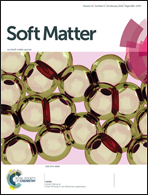Interactions between brush-grafted nanoparticles within chemically identical homopolymers: the effect of brush polydispersity†
Abstract
We systematically examined the polymer-mediated interparticle interactions between polymer-grafted nanoparticles (NPs) within chemically identical homopolymer matrices through experimental and computational efforts. In experiments, we prepared thermally stable gold NPs grafted with polystyrene (PS) or poly(methyl methacrylate) (PMMA), and they were mixed with corresponding homopolymers. The nanocomposites are well dispersed when the molecular weight ratio of free to grafted polymers, α, is small. For α above 10, NPs are partially aggregated or clumped within the polymer matrix. Such aggregation of NPs at large α has been understood as an autophobic dewetting behavior of free homopolymers on brushes. In order to theoretically investigate this phenomenon, we calculated two particle interaction using self-consistent field theory (SCFT) with our newly developed numerical scheme, adopting two-dimensional finite volume method (FVM) and multi-coordinate-system (MCS) scheme which makes use of the reflection symmetry between the two NPs. By calculating the polymer density profile and interparticle potential, we identified the effects of several parameters such as brush thickness, particle radius, α, brush chain polydispersity, and chain end mobility. It was found that increasing α is the most efficient method for promoting autophobic dewetting phenomenon, and the attraction keeps increasing up to α = 20. At small α values, high polydispersity in brush may completely nullify the autophobic dewetting, while at intermediate α values, its effect is still significant in that the interparticle attractions are heavily reduced. Our calculation also revealed that the grafting type is not a significant factor affecting the NP aggregation behavior. The simulation result qualitatively agrees with the dispersion/aggregation transition of NPs found in our experiments.



 Please wait while we load your content...
Please wait while we load your content...